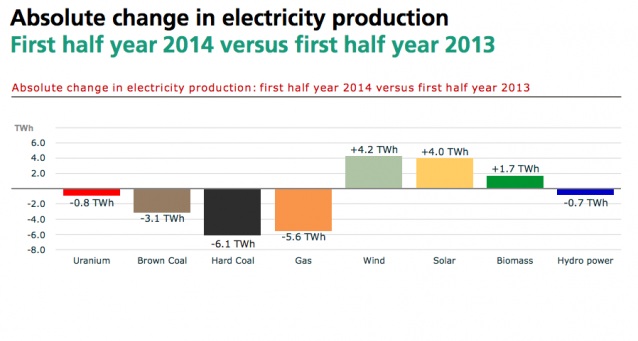Bye-bye brown coal: Germany's new renewables mark
Thanks to favourable weather and record production from solar and wind power, renewable energy accounted for approximately 31 per cent of Germany’s electricity generation in the first half of 2014.
Non-hydro renewables made up 27 per cent of the country’s power, up from 24 per cent last year, according to new data released by the Fraunhofer Institute. And for the first time ever, renewable energy sources accounted for a larger portion of electricity production than brown coal.
Production of wind and solar in particular saw substantial gains over the same time last year. Solar grew by 28 per cent in the first half of 2014 compared to 2013 and wind power grew by 19 per cent over the same period last year.
“Solar and wind alone made up a whopping 17 per cent of power generation, up from around 12-13 per cent in the past few years,” reported Renewables International.

Source: B. Buger/FRAUNHOFER ISE
Helped along by low demand on a holiday, Germany nevertheless set another solar power record in June, generating 50 per cent of its overall electricity demand from solar for part of the day. And in May, renewable energy sources combined to account for 75 per cent of power demand for part of the day.
As a point of comparison, approximately 13 per cent of the US electricity supply was powered by renewables as of the end of 2013, roughly half of Germany’s rate.
Dr Bruno Burger with the Fraunhofer Institute explained that the gains made by renewables thus far in 2014 can be attributed to the combination of good weather and growing production of clean energy. “In the first half year 2013 we had really bad weather and the solar and wind production was below the long term average,” Burger said via email. “In 2014 we started with more [sun] and wind and the production is higher than in average years.”
The Fraunhofer Institute’s analysis found that brown coal generation is down four per cent and the production of hard coal-fired power plants decreased 11 per cent from 2013′s record levels. However, in the first half of 2014, brown coal production was still at the high level of 2012 and about five per cent above the average of the last 10 years. Gas power plants saw the largest decline, with generation down 25 per cent compared to the same period last year.
For his calculation, Burger used the production of power plants for public electricity and said that once the data becomes available for self-production of big industrial companies later this year, the total per centage of electricity generated by renewables may dip slightly to around 28 per cent.
Burger also pointed out the increase in electricity exports thus far in 2014. “Despite the fact that we had high production of renewables, we did not reduce the conventional production,” he said. “Therefore we achieved an export surplus of 18 terawatt-hours. If this trend continues until the end of the year, Germany will achieve a third record in a row in electricity exports.”
Germany’s Energiewende, or energy transformation, is an ambitious plan that aims to achieve 80 per cent renewable energy generation by 2050. While the country has been criticized for its continued reliance on coal-fired generation, Craig Morris at Renewables International argues that it’s the electricity exports keeping coal production high. Renewable electricity has priority on the German grid and therefore offsets conventional (fossil fuel) generation, meaning that much of conventional generation will go to neighboring countries as exports.
Morris points out that the net importers of German power don’t order it directly from one source, like coal or wind, but receive the electricity mix, which is typically one-quarter renewables but can vary depending on production. “Nonetheless,” he writes, “the effect of net exports on German power production is to raise the share of conventional electricity, which would otherwise be offset by renewables.”
Originally published on Climate Progress. Reproduced with permission.
















